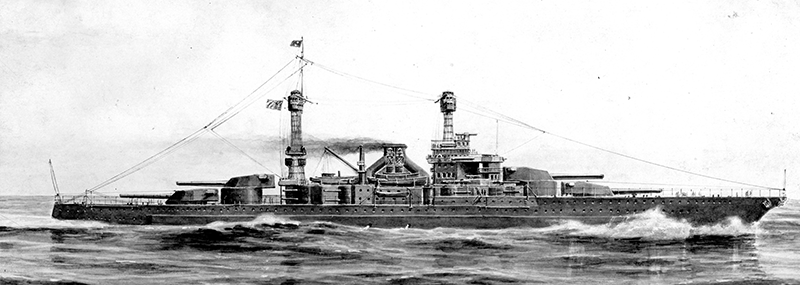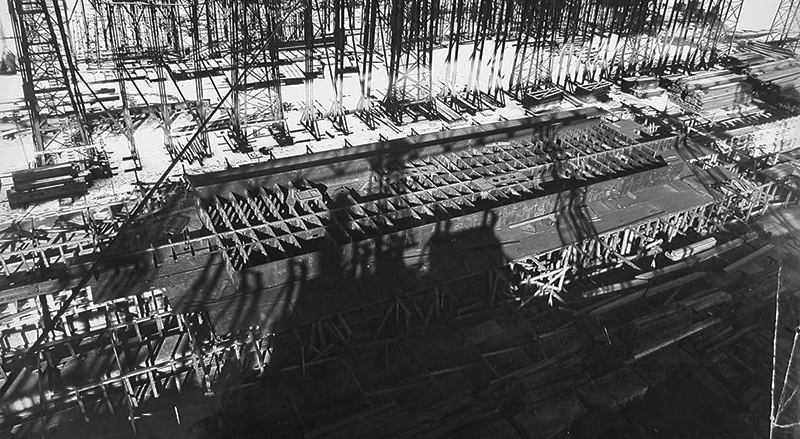

South Dakota
| No | Name | Yard No | Builder | Laid down | Launched | Comm | Fate |
| BB49 | South Dakota | New York N Yd, Brooklyn | 15.3.1920 | --- | --- | cancelled 8.2.1922 | |
| BB50 | Indiana | New York N Yd, Brooklyn | 1.11.1920 | --- | --- | cancelled 8.2.1922 | |
| BB51 | Montana | Mare Island N Yd, Vallejo | 1.9.1920 | --- | --- | cancelled 8.2.1922 | |
| BB52 | North Carolina | Norfolk N Yd, Portsmouth | 12.1.1920 | --- | --- | cancelled 8.2.1922 | |
| BB53 | Iowa | 258 | Newport News | 17.5.1920 | --- | --- | cancelled 8.2.1922 |
| BB54 | Massachusetts | 1400 | Fore River, Quincy | 4.4.1921 | --- | --- | cancelled 8.2.1922 |
|
Displacement normal, t |
43200 |
|
Displacement full, t |
|
|
Length, m |
201.2 wl 208.5 oa |
|
Breadth, m |
32.3 |
|
Draught, m |
10.1 |
|
No of shafts |
4 |
|
Machinery |
4 electric motors, 4 turbo-generators, 12 boilers |
|
Power, h. p. |
60000 |
|
Max speed, kts |
23 |
|
Fuel, t |
oil 2100 (emergency 6600) |
| Endurance, nm(kts) | 8000(10) |
|
Armour, mm |
belt: 343 - 203, bulkheads: 343 - 203, deck: 89, splinter deck: 38, uptakes: 343 - 229, barbettes: 343 - 114, turrets: 457 face, 254 sides, 229 rear, 127 crown, CT: 406 sides, 203 roof |
|
Armament |
4 x 3 - 406/50 Mk 2, 16 x 1 - 152/53 Mk 12, 4 x 1 - 76/52 Mk 10, 2 - 533 TT (beam) |
|
Complement |
1191 |
Project history: With this class the General Board finally achieved what it had wanted since 1914, a jump in battleship capabilities and size. From the start, the board wanted 12x406mm guns and a 23kt speed, the latter partly out of fear that Japan would acquire fast battleships (like the British Queen Elizabeths) of her own. The board considered a 2kt increase an absolute minimum, given what it supposed was a general tendency towards higher speed. Finally, given a great increase in displacement, it was natural to go from the existing 406mm/45 to the much more powerful 406mm/50, and from the 127mm/51 secondary gun to the new 152mm/53. Armour thicknesses did not increase, largely because 343mm was considered the maximum that could be manufactured with any certainty of consistent quality. Main battery elevation was increased to 40 degrees.
The design, then, amounted to an enlarged Maryland, with triple rather than twin turrets, and with all of the secondary battery above the forecastle deck. Visually, the most unusual feature would have been the massive trunked funnel, uniting four smokepipes emerging from the dispensed boiler rooms.
This design was frozen in the summer of 1918. At that time the US naval staff in London was much impressed by HMS Hood, and it proposed that the United States develop its own fast battleship, armed with 406mm guns. Several sketches were prepared, but the General Board fell that to build them would make existing ships obsolete, and therefore would not be in the US Navy's best interests. It therefore persevered with the much more conventional South Dakota design.
Delayed by the emergency ASW program of World War One, the ships were not laid down until after the war, and none was very advanced at the time of the Washington Conference, when all were cancelled.
Ship protection: Armour belt had 5.2m height and was 343mm thick at upper 3.2m part tapering to 203mm at lower edge. Belt was connected with end barbettes by 343mm bulkheads. There was 2.6m in height 203mm belt aft from aft bulkhead, protecting steering gear, it was closed aft by 343mm bulkhead. Flat main armour deck was connected with upper edge of belt and was 89mm over citadel. One level lower there was flat 38mm splinter deck. This deck was 159mm thick with 159mm slopes aft from citadel, protecting steering gear and was closed by 203mm bulkhead. TTs were protected by 127mm deck at level of lower edge of main belt. Main gun turrets had 457mm faces, 254mm sides, 229mm rears and 127mm crowns. Barbettes were 320mm over and 102-114mm under main deck. CT had 406mm sides and 203mm roof. Funnel uptakes were protected by 229mm armour. Underwater protection was 5.3m deep.

South Dakota Artwork by F. Muller, circa 1920.


Massachusetts at Bethlehem Shipbuilding Corp., Quincy, Mass. on 14 February 1922. Work had been stopped on her 6 days earlier. She was 11% completed at this time.
© Navypedia, 2020